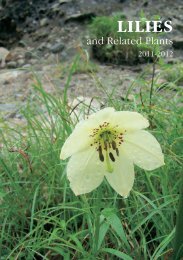LILIES - RHS Lily Group
LILIES - RHS Lily Group
LILIES - RHS Lily Group
Create successful ePaper yourself
Turn your PDF publications into a flip-book with our unique Google optimized e-Paper software.
Mount Shasta, rising to 14,162ft was the dramatic backdrop to part of the author’s<br />
summer lily chase.<br />
The following day we set off for Pole Creek to look for L. parvum.<br />
Unfortunately, all but one of the plants we found were still in bud and the plant<br />
that was flowering was fasciated. However, luck was with us, as we headed<br />
north to Yreka, when we found a number of L. parvum and L. pardalinum<br />
growing in a roadside ditch. Although somewhat unromantic as a name, “ditch<br />
lilies” does accurately describe L. parvum and L. pardalinum (and others of their<br />
ilk) in relation to their inclination to grow and flourish in the boggy habitats man<br />
creates through the process of building roads. The “chicken or egg” question<br />
is, were the ditch lilies there before the roads were built, or did they colonise<br />
these ideal habitats after the roads were built? The next lily we encountered was<br />
L. washingtonianum. Again the plants were growing beside the road, not in a<br />
ditch, but near the top of a slope in very dry, loose soil. This would appear to be<br />
the perfect growing environment for this lily, as, in the words of Dr Albert Kellogg<br />
(after whom L. kelloggii was named), “At no time have I met with a plant of this<br />
species in a soil the drainage of which was not perfect and when found on a<br />
slope did not face towards some point between east and south.” I can’t swear to<br />
72




